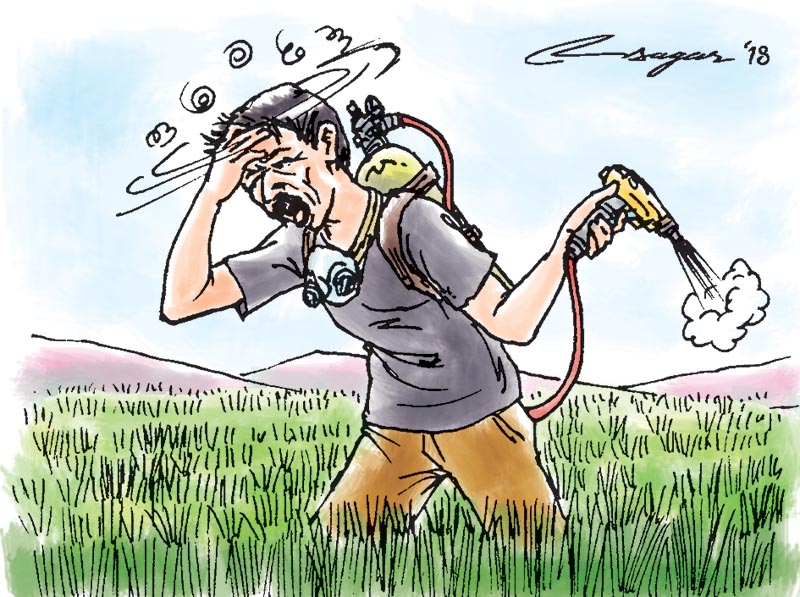Pesticide poisoning: Ways to deal with it
Pesticide self-poisoning is a major contributor to global burden of suicide. Increased awareness among farmers and pesticide retailers about harm due to exposure to pesticides can be help reduce pesticide related morbidity and mortality
Nepal is an agricultural country. Agriculture is the mainstay of Nepali economy with its contribution to the gross domestic product hovering around 30 per cent. In an agriculture country like Nepal, use of pesticides is but obvious, for they save crops and help in ensuring good yields.
Pesticides are chemical compounds that are used to kill pests, including insects, rodents, fungi and unwanted plants (weeds). Nepal has experienced an increasing tendency to use pesticides by about 10 per cent to 20 per cent per year, and more than 90 per cent of the total pesticides are used in vegetable farming.
Till 2013, pesticides of 107 common names including 44 insecticides, four acaricides, 31 fungicides, two rodenticides, one molluscicide, six bio-pesticides, 18 herbicides and one bactericide are registered under Pesticide Registration and Management Division (PRMD).
But just as pesticides can save crops, they can take lives of people also. Limited knowledge and practice among farmers and retailers on proper protection, safe storage and spraying interval before harvest have led to increased risk of pesticide poisoning.
Pesticides are also commonly being used to commit suicide in Nepal because it is easily available and affordable.
Pesticide self-poisoning is a major contributor to the global burden of suicide. In Nepal, it is the second commonly used method of suicide (the first being hanging). Only few hospital-based data are available, and neither large scale nor nationwide study has been done to measure the scale of poisoning problem in Nepal.
Published literatures on poisoning clearly identify pesticide ingestion as one of the commonest modes of self-harm in the last couple of years. Among the different types of pesticides available, organophosphorus is the most common compound used for self-poisoning.
However, we are unable to say the exact trends in pesticide poisoning over the years. This calls for research for planning different strategies to reduce pesticide poisoning related morbidity and mortality.
In Nepal, pesticides were introduced in 1952 and pesticide regulations were introduced in 1993. Integrated Pest Management (IPM) has been a major programme of the government for the last two decades to mitigate irrational and overuse of chemical pesticides.
Recently, on March 16, 2018, a group of experts from 10 different hospitals of the country, stakeholders related to pesticides and Nepal Police official held discussions on the burden of pesticide self-harm in Nepal, different strategies to minimise the use of pesticide and other relevant issues to reduce suicide rate relating to pesticide ingestion in Nepal. The programme was organised by Centre for Pesticide Suicide Prevention (CPSP), University of Edinburgh.
The director of CPSP, Prof Michael Eddleston, a clinical toxicologist who has worked on pesticides suicides for more than 20 years particularly based on Sri Lanka, highlighted the importance of education to the people about pesticides and demerit of pesticides and shared his experience on reducing deaths from pesticide in Sri Lanka. Eddleston shared his experience on effective treatment modalities of acute pesticide poisoning to all the medical professionals participated in the workshop.
An official from Nepal Police presented data on suicide due to poisoning in Nepal in three years’ period, which showed suicide among males was more compared to females.
CPSP, with Prof Eddleston as the principal investigator, has started a two-year research “Highly Hazardous Pesticide Poisoning-Gathering Requisite information for Decision-making for Effective Suicide Prevention
(HOPE GRID)” in Nepal in collaboration with Nepal Public Health Foundation with an objective to identify highly hazardous pesticide that can help in regulation of pesticide use in the years to come.
Increased awareness among farmers and pesticide retailers about harm due to exposure to pesticides and enhancing their knowledge and practice for safe handling of pesticides can be one of the strategies to reduce pesticide related morbidity and mortality.
Likewise, strict rules regarding sale of pesticide must be implemented. Banning highly hazardous pesticides will help to reduce overall national suicide numbers.
So far, 16 pesticides have been banned in Nepal by PRMD. The existing poisoning management system should be development and implementation of national treatment guidelines in all the hospitals and update as required, ensuring availability of drugs and antidotes, early referral system to higher centres for cases requiring further treatment and establishing poison information centres, strengthened by establishing and/ or expanding poisoning database, regular training of physicians.
Efforts are needed to improve the comprehensiveness and quality of data to obtain better estimates of pesticide poisoning in Nepal and that would aid in the development of different approaches to prevent morbidity and mortality associated with the use of pesticides.
Ghimire is assistant professor at Department of Clinical Pharmacology, TUTH, & co-principal investigator, HOPE GRID






